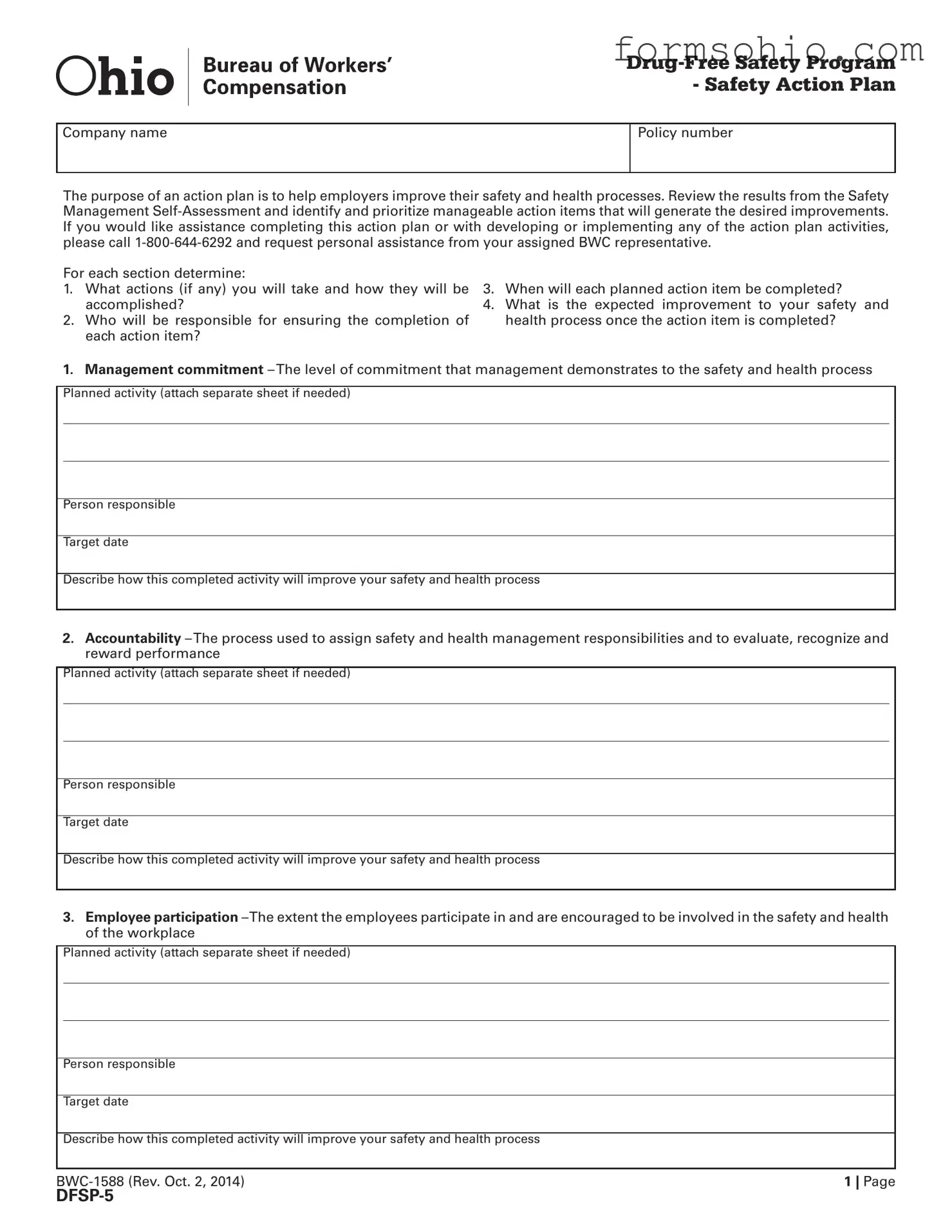Drug-Free Safety Program - Safety Action Plan
The purpose of an action plan is to help employers improve their safety and health processes. Review the results from the Safety Management Self-Assessment and identify and prioritize manageable action items that will generate the desired improvements. If you would like assistance completing this action plan or with developing or implementing any of the action plan activities, please call 1-800-644-6292 and request personal assistance from your assigned BWC representative.
For each section determine:
1.What actions (if any) you will take and how they will be accomplished?
2.Who will be responsible for ensuring the completion of each action item?
3.When will each planned action item be completed?
4.What is the expected improvement to your safety and health process once the action item is completed?
1.Management commitment –The level of commitment that management demonstrates to the safety and health process
Planned activity (attach separate sheet if needed)
Person responsible
Target date
Describe how this completed activity will improve your safety and health process
2.Accountability –The process used to assign safety and health management responsibilities and to evaluate, recognize and reward performance
Planned activity (attach separate sheet if needed)
Person responsible
Target date
Describe how this completed activity will improve your safety and health process
3.Employee participation –The extent the employees participate in and are encouraged to be involved in the safety and health of the workplace
Planned activity (attach separate sheet if needed)
Person responsible
Target date
Describe how this completed activity will improve your safety and health process
BWC-1588 (Rev. Oct. 2, 2014) |
1 | Page |

4.Safety culture –The organizational values, management style, environment and social norms related to safety and health
Planned activity (attach separate sheet if needed)
Person responsible
Target date
Describe how this completed activity will improve your safety and health process
5.Hazard prevention and control –The process to identify and correct unsafe acts and conditions
Planned activity (attach separate sheet if needed)
Person responsible
Target date
Describe how this completed activity will improve your safety and health process
6.Safety and health training and education – The process of ensuring safety education and training is provided to people at all levels, and that skills are assessed to ensure understanding
Planned activity (attach separate sheet if needed)
Person responsible
Target date
Describe how this completed activity will improve your safety and health process
7.Accident analysis – The method of gathering and analyzing accident information; determining root causes and identifying safety improvements to prevent future accidents
Planned activity (attach separate sheet if needed)
Person responsible
Target date
Describe how this completed activity will improve your safety and health process
BWC-1588 (Rev. Oct. 2, 2014) |
2 | Page |

8.Workers’ compensation claims management –The management process for ensuring timely filing of claims, care for injured workers, and minimizing the financial impact of claims on the organization
Planned activity (attach separate sheet if needed)
Person responsible
Target date
Describe how this completed activity will improve your safety and health process
9.Return-to-work practices –The management process for ensuring a safe, efficient return to work by injured workers to help reduce financial burdens on the employee and employer
Planned activity (attach separate sheet if needed)
Person responsible
Target date
Describe how this completed activity will improve your safety and health process
10.Employee health promotion (wellness) – The organization’s efforts to encourage personal health improvement and health maintenance among its employees
Planned activity (attach separate sheet if needed)
Person responsible
Target date
Describe how this completed activity will improve your safety and health process
X
Signature of company official responsible for this action plan |
Date submitted |
BWC-1588 (Rev. Oct. 2, 2014) |
3 | Page |



